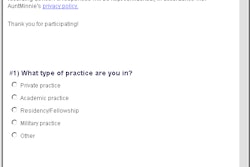NEW ORLEANS - As the general population grows gray and healthcare needs skyrocket, the current radiologic technologist shortage is threatening to become a full-blown crisis. Helping administrators forestall the expected workforce drain is the first priority of the American Society of Radiologic Technologists, promised CEO Lynn May.
In a presentation Sunday at the American Healthcare Radiology Administrators meeting, May outlined some of the projects the ASRT is working on in an effort to rebuild this dwindling segment of the imaging industry.
"We think the next 10 years are going to be like the last 10 years in that there is going to be a tremendous amount of change in the field. It’ll certainly be driven by technology, with a lot of other factors that are going to have a profound impact on the way care is delivered," May said in his introduction.
According to ASRT estimates, there are currently 212,000 radiographers in the U.S., including 44,000 mammographers and 12,000 MR technologists. Over the next 20 years, the aging baby boom population is expected to generate 48% more hospital visits. The total number of imaging exams will jump to 500 million annually, up from 350 million right now. As a result, the imaging community must come up with 75,000 more RTs in order to meet these healthcare demands.
The patients aren’t the only ones getting old: The rate at which RTs are leaving the profession, mostly due to retirement, is greater than the number of new people entering the field. In addition, more working technologists are shifting their attention to specialized imaging, such as CT and MRI, because it is more lucrative. These elements will combine to form what May called "a dangerous imbalance in the field."
"People these days have a lot of options in terms of career choices, and those are not necessarily in healthcare. It’s going to be very hard to meet (supply) numbers in the future," he said. "It’s going to be brutal to find people."
The ASRT’s first answer to softening the blow is a free recruitment and retention tool kit that is available through the society’s Web site. The kit offers guidance on setting up an RT scholarship program, becoming a clinical teaching site, writing job descriptions, and, most important, retaining employees.
The ASRT also plans to revamp the current educational standards set for RTs. Under their new plan, x-ray technologists would have to earn at least an associate’s degree, while radiation therapists would be required to have a bachelor’s degree. The Consumer Assurance of Radiologic Excellence (CARE) bill would set educational and credential standards.
The society’s biggest push is for the creation of a new position, called a radiologist assistant (RA).
"In the past, an RT really only had about four options if they wanted to make more money or achieve more status," May said. "Those were to go into education, management, industry as a (sales) rep or applications specialist, or to go into more specialized imaging. But three of those four basically took people out of direct patient care."
The RA position would call for a baccalaureate education. He or she would work under the supervision of the radiologist, concentrating on patient assessment, education, and care. They would have the ability to make initial image observations and report them to the radiologist.
"This is not a physician’s assistant," May said. "What we’re talking about is someone who is an advanced RT. They are an extender between the RT and the radiologist."
To help kick-start the RA concept, the ASRT will offer four $25,000 grants per year to facilities or institutions that develop RA programs, May said.
Another new job will be that of a radiologic technologist aide, who would provide support services in the department to enable RTs to focus on patient care. This individual would not perform imaging exams or provide direct patient care.
While AHRA session attendees expressed support for the ASRT’s efforts, they did voice some concerns over the creation of these limited practice positions.
One audience member said she feared that a radiologist assistant, who would be trained to perform some fluoroscopic exams, would clash with radiology residents. Another attendee questioned the value of greenlighting new imaging professionals just so they can go to work right away and potentially miss out on crucial education. Others were concerned that more stringent educational requirements would mean fewer practice hours for the new breed of radiologic technologists.
May countered that "we’re suffering because the (RT) profession has never stabilized or standardized its education at entry level." Creating uniform educational standards is one way for the RT field to shed some of its negative image as a career with limited pay, little chance for advancement, and haphazard regulation, he said.
Overall, May encouraged the attendees to concentrate on workforce development by investing in new technology, adjusting payscales to meet market demands, and developing clinical sites that offer hands-on, practical experience. The latter can provide an excellent pool of future employees, and allow current staff to take on more responsibility as instructors and mentors, he added.
By Shalmali PalAuntMinnie.com staff writer
July 30, 2002
Copyright © 2002 AuntMinnie.com



















